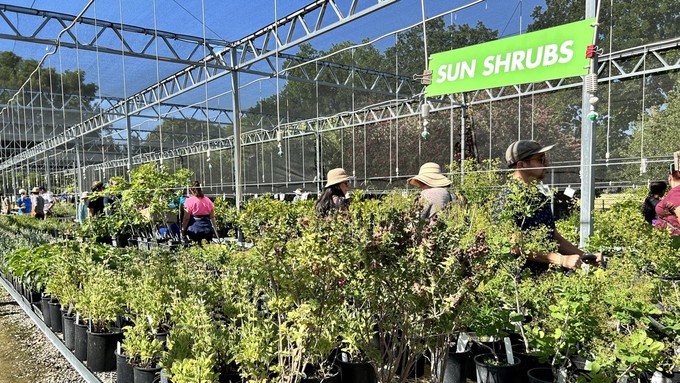
Members-only event features huge selection of water-wise plants; join at the gate

The weather likely won't be as pleasant Saturday as in this photo, but the tables at the UC Davis Teaching Nursery will be just as full for the first spring Plant Sale of 2024. This will be a members-only event. Kathy Morrison
That also makes this the perfect week for a plant sale!
On Saturday, March 9, the UC Davis Arboretum’s Teaching Nursery starts its spring cycle of plant sales with its annual Spring Members Appreciation Sale. From 9 a.m. to 1 p.m., members of Friends of the Arboretum get the run of the 1-acre nursery and first pick of the arboretum’s spring selections – plus a 10% discount.
Not a member? No problem! Join in advance online or at the gate and get a new member gift ($10 coupon for the sale) as well as the discount.
Split sales (with the first hour reserved for members only) will be held April 7 and 27. The spring clearance sale is set for May 11. Hours are 9 a.m. to 1 p.m. for each sale.
“Shop our 1-acre nursery to find an incredible selection of attractive, low-water plants perfect for our region,” says the arboretum staff. “By choosing to shop with us, not only will you bring home beautiful plants that help support a sustainable environment, your purchases play a vital role in supporting the growth and care of our gardens, student environmental leadership opportunities, and free public programs.
“Discover the joys of gardening with plants that help heal our environment while nurturing our community!”
Volunteers are still needed to staff the sales. The nursery seeks customer assistants, cashiers, plant counters and other volunteers to help these events run as smoothly as possible. Find the forms to sign up here: https://arboretum.ucdavis.edu/plant-sales.
That same link also leads to downloadable inventory lists of the hundreds of varieties that will be available as well as many photos. The inventory lists are invaluable tools to get the most out of these sales.
Take it from our experience: Research plants before you shop, and compile a list with the plant locations. Bring a wagon or rolling cart if you have one: Often early in the sale there's a waiting list for the nursery wagons.
The Arboretum Teaching Nursery is located at 1046 Garrod Drive, Davis, on the UC Davis campus near the small animal veterinary hospital. Parking is available in the adjoining lots. Student volunteers stationed on corners can direct visitors to parking areas.
Details and directions: https://arboretum.ucdavis.edu/.
Comments
0 comments have been posted.Sacramento Digs Gardening to your inbox.
Food in My Back Yard Series
May 6: Maintain soil moisture with mulch for garden success
April 29: What's (already) wrong with my tomato plants?
April 22: Should you stock up on fertilizer? (Yes!)
April 15: Grow culinary herbs in containers
April 8: When to plant summer vegetables
April 1: Don't be fooled by these garden myths
March 25: Fertilizer tips: How to 'feed' your vegetables for healthy growth
March 18: Time to give vegetable seedlings some more space
March 11: Ways to win the fight against weeds
March 4: Potatoes from the garden
Feb. 25: Plant a fruit tree now -- for later
Feb. 18: How to squeeze more food into less space
Feb. 11: When to plant? Consider staggering your transplants
Feb. 4: Starting in seed starting
Sites We Like
Garden Checklist for week of May 11
Make the most of the lower temperatures early in the week. We’ll be back in the 80s by Thursday.
* Plant, plant, plant! It’s prime planting season in the Sacramento area. Time to set out those tomato transplants along with peppers and eggplants. Pinch off any flowers on new transplants to make them concentrate on establishing roots instead of setting premature fruit.
* Direct-seed melons, cucumbers, summer squash, corn, radishes, pumpkins and annual herbs such as basil.
* Harvest cabbage, lettuce, peas and green onions.
* In the flower garden, direct-seed sunflowers, cosmos, salvia, zinnias, marigolds, celosia and asters. (You also can transplant seedlings for many of the same flowers.)
* Plant dahlia tubers.
* Transplant petunias, marigolds and perennial flowers such as astilbe, columbine, coneflowers, coreopsis, dahlias, rudbeckia and verbena.
* Keep an eye out for slugs, snails, earwigs and aphids that want to dine on tender new growth.
* Feed summer bloomers with a balanced fertilizer.
* For continued bloom, cut off spent flowers on roses as well as other flowering plants.
* Add mulch to the garden to maintain moisture. Mulch also cuts down on weeds. But don’t let it mound around the stems or trunks of trees or shrubs. Leave about a 6-inch-to-1-foot circle to avoid crown rot or other problems.
* Remember to weed! Pull those nasties before they set seed.
* Water early in the day and keep seedlings evenly moist.